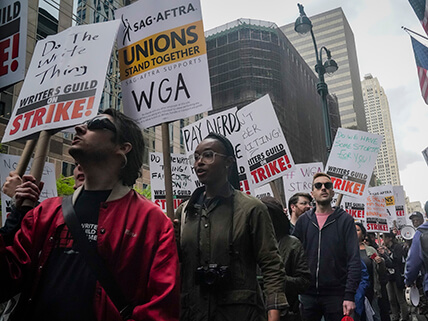
Striking writers march and picket calling for better wages, outside Peacock NewFronts in New York.
Do you watch TV? How about movies? Some of the stories you see are exciting, some are sad, some are funny, and some are scary. One thing that they all have in common, though, is that someone wrote them. Those people are called screenwriters because they write for either the small screen—television—or the big screen—movies.
Screenwriters are currently on strike. In a strike, workers refuse to work until employers meet their demands. The striking screenwriters belong to a union—the Writers Guild of America (WGA). A union is a workers’ group that fights for better working conditions and pay. TV and movie studios are part of the Alliance of Motion Picture and Television Producers (AMPTP). This is the group that represents their industry.
There is a long history of collective bargaining in the United States. Collective bargaining is when employers—like the AMPTP—and unions—like the WGA—meet to discuss and agree on working conditions. Past collective bargaining negotiations between unions and employers created benefits for workers—like the 5-day work week—that still exist today. When employers and employees can’t come to an agreement, employees often have no choice but to call a strike.
The last screenwriters’ strike was in 2007. It lasted 100 days and cost the economy more than $2 billion. As part of the agreement to end the 2007 strike, the WGA negotiated a minimum rate for screenwriters. In 2013, about one-third of screenwriters were working at this minimum rate.
Since then, streaming services have become much more popular. The rise of streaming has resulted in fewer long-term writing jobs. Instead, writers are often hired for only a few weeks or months and paid at a lower rate. In 2022, about half of all screenwriters were working at the minimum rate.
In addition, screenwriters are concerned about Artificial Intelligence (AI). Users can ask AI chatbots to create articles, essays, and even scripts. Right now, the technology isn’t close to producing the quality needed for major TV and movie scripts. But, it is rapidly improving. Screenwriters fear that studios may one day be able to use AI in a way that eliminates human jobs.
The use of AI—now and in the future—is one of the major sticking points in negotiations between the WGA and AMPTP. The WGA wants clearly defined rules about how AI can be used for script writing. The AMPTP wants the option to make use of AI as the technology improves. The AMPTP has suggested renegotiating the use of AI each year.
Recently, negotiations have broken down between the WGA and AMPTP. Both sides seem to be far apart on an agreement to end the strike. In time, the two groups will resume negotiations and reach a compromise. However, experts believe that a deal will likely not be reached until at least mid-July. If the strike stretches later into the summer it could jeopardize the TV schedule for new shows in the Fall.
Image credit:
©Bebeto Matthews/AP Images
Sources:
- Why Hollywood writers are striking and the immediate impact
(Source: AP News; accessed June 1, 2023) - Could AI pen ‘Casablanca’? Screenwriters take aim at ChatGPT
(Source: AP News; accessed June 1, 2023) - How the WGA Decided to Harness — but Not Ban — Artificial Intelligence
(Source: Variety; accessed June 1, 2023) - Biden calls for ‘fair deal’ for writers as strike continues
(Source: CNN; accessed June 1, 2023) - The Luddites of Hollywood
(Source: The Atlantic; accessed June 1, 2023) - Your Most Frantic Writers’ Strike Questions, Answered
(Source: Vulture; accessed June 1, 2023) - ‘It’s just pure chaos’: Top Hollywood showrunners explain the writers’ strike
(Source: LA Times; accessed June 1, 2023) - When Will the Writers Strike End?
(Source: Vanity Fair; accessed June 1, 2023) - Everything to Know About the Hollywood Writers Guild Strike, Including the TV Shows and Movies Affected
(Source: People; accessed June 1, 2023) - Writers Are Not Keeping Up
(Source: Writers Guild of America; accessed June 1, 2023)



